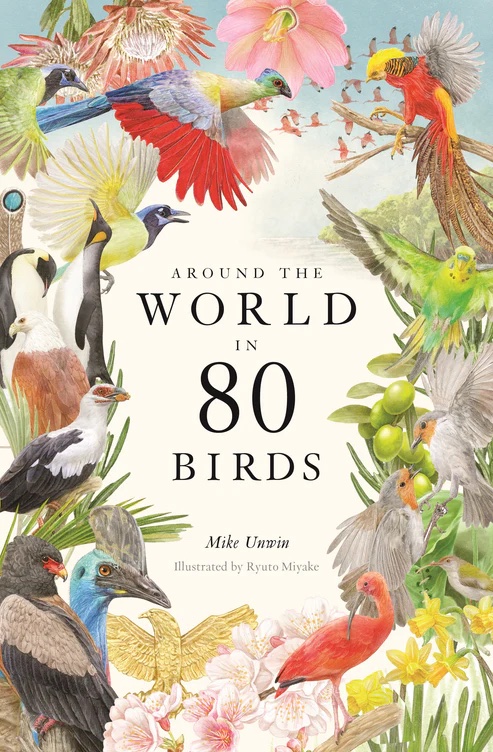A couple of years ago I read Around the World in 80 Trees. I enjoyed the writing by Jonathan Drori and the lovely illustrations by Lucille Clerc. Well, the folks at Laurence King Publishing know when they’re onto a good thing and they’ve come out with another around-the-world-tour, this time with birds.
Around the World in 80 Birds follows the same structure its predecessor. After a brief introduction, we embark on a continent-by-continent survey of birds. Of course, you can flit through the book in any order, dipping in and out as you like. For each species, there’s a one- to one-and-a-half page profile written by Mike Unwin, a UK-based freelance writer of nature books for adults and kids. Unwin describes the birds, their behavior, habitat and relationship to humans. The book is brought to life by the wonderful illustrations created by Ryuto Miyake, an illustrator and graphic designer from Tokyo.
Around the World in 80 Birds
By Mike Unwin. Illustrated by Ryuto Miyake
Laurence King Publishing, London, 2022
Worldwide, there are about 11,000 recognized bird species. It’s impossible to select just 80 representatives that everyone agrees with. So Unwin admits he’s probably included some that might seem questionable, and excluded others, like woodpeckers, that are popular favorites. Personally, I was delighted to see the laughing kookaburra, the Atlantic puffin and especially the common loon included, though I think the eagles are over-represented. See: impossible to please everyone!
Unwin says he tried to select bird species that have particular significance in the regions where they’re found. Seems like a reasonable criterion to me. And it leads to a good mix of both familiar and lesser-known birds.
I knew about some of them from reading books like Scott Weidensaul’s A World on the Wing and Jennifer Ackerman’s What an Owl Knows. But I also learned some fascinating new details.
- Arctic terns breed in the Arctic but spend northern winters in the Antarctic where it’s summer. In other words, terns migrate from the Arctic to the Antarctic and back every year. An incredible distance. As a result, they never experience winter, and, Unwin notes, probably see more daylight than any other animal on Earth.
- The bar-headed goose migrates from the wetlands of India to its breeding grounds on the high plateaus of central Asia. Its route takes it over the Himalayas where it must fly at extraordinary altitudes exceeding 20,000 feet. It has special adaptations that allow it to breathe and fly in such thin air.
- The European robin is unrelated to the American robin. The American robin (actually a kind of thrush) was so named by homesick British settlers who attached that name to the first red-breasted bird they saw. The European variety is, apparently, quite tame, hanging about while gardeners work the soil, hoping to snatch up any exposed insects. By the way, neither have red breasts: they’re orange.
An important theme of the book is that many of these birds are threatened or endangered, mainly by habitat loss along their migration flyways, but also by hunting, pesticides and industrial development. Increasingly, the ecosystems many of them rely on are threatened by climate change.
Unwin started writing the book in the early stages of the COVID-19 pandemic. His experience echoes my own, and I suspect many others’:
“In my own corner of the world, amid the ensuing fear and confusion, birds quickly became a source of comfort and escape to millions who – trapped at home and unable to work, travel or visit loved ones – began peering into the sky on their daily socially distanced walks or listening to the voices that filled the new silence. To many, these delights were a revelation. The challenge now is not to forget; to turn this newfound awareness into action that shores up the future of birdlife around the planet. Birds need us. And, what’s more, we need them.” [p. 11]
Thanks for reading
Click here for more posts about birds.
If you enjoyed this review, please subscribe to Unsolicited Feedback.


A nice summary with a big impact, as always.
Birds must be on the minds of many. LIFE magazine’s current issue is Birds The World’s Most Remarkable Creatures.
Appreciate the gems you extract and share, Harry!
LikeLiked by 1 person